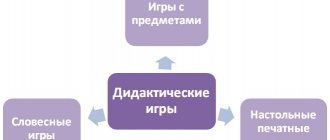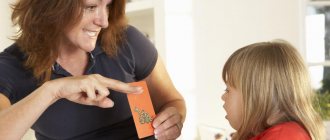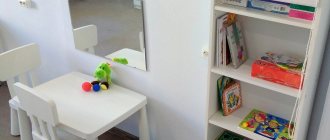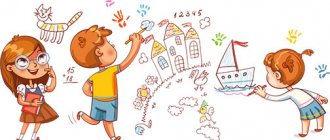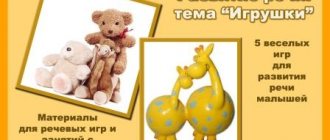LiveInternetLiveInternet
Quote from Kseneia's message
Read in full In your quotation book or community!
Games for developing correct sound pronunciation in children with dyslalia"
Anya, I have only such games for my card index so far, I’ll look at them again, then I’ll add them
“Games for developing correct sound pronunciation in children with dyslalia”
Selection of methodological material for working with children with dyslalia:
GAMES FOR FORMING CORRECT SOUND PRONUNCIATION
1) FORMATION OF HISSING SOUNDS Ш, Ж, Х, Ш
a) "Silence"
Target. Automation of sound w.
Description of the game. The driver stands at one wall, and all the other children stand at the opposite wall. Children should quietly, on tiptoe, approach the driver; with every careless movement, the driver makes a warning sound sh-sh-sh, and the sensational one must stop. Whoever quietly reaches the driver first becomes the driver himself.
b) "Train"
Target. Automation of the sound sh in syllables and words.
Description of the game. Children stand one after another, pretending to be a train. Ahead of the train is a steam locomotive (one of the children). The train departs on the command “Go-go, go-go, go-go.” The pace gradually accelerates. They drive up to the station (an appointed place or a building made of cubes) and say: “I came, I came, I came” (slowly: sh, sh, sh - let off steam). Then the bell is given, the whistle is blown, and the movement resumes.
Note. You can introduce semaphore and ticket sales into the game. You can complicate the game - children will depict different trains, for example, fast and freight. The ambulance moves to the sounds of shu-shu-shu - (fast), the freight one - shsshu-shshu (slowly).
c) “Bees and Cubs”
Target. Automation of sound g.
Description of the game. The playing children are divided into two groups: one group is bees, the other is bear cubs. Bees climb onto the gymnastic wall (or chairs). This is a beehive. The cubs are hiding behind a tree (bench). Hearing the signal “Bees, for honey!”, the children go down to the floor, run to the side and, like bees, fly from flower to flower. At this time, the cubs climb over the bench and walk on all fours to the hive. At the signal “The bears are coming, the bees return with the sound of zh-zh-zh. And the cubs quickly straighten up and run away.
When repeating the game, children change roles.
d) "Greedy cat"
Target. Differentiation of sounds sh-zh.
Description of the game. They choose a driver. He's a cat. The cat sits in the corner and says: “I’m a terribly greedy cat, I catch all the mice - and in my mouth.” The rest of the children are mice. They pass by the cat and whisper in fear: “Hush, hush, the cat is getting closer, closer.” Children say these words twice. With the last words, the cat jumps out and catches the mice. Anyone caught in the cat’s paws must say the words “quieter” and “closer” 5-10 times. Then the role of the cat is transferred to another child, and the game continues.
d) “Sparrows”
Target. Automation of the sound h in onomatopoeia.
Description of the game. Children (sparrows) sit on chairs (in nests) and sleep. In response to the teacher’s words, “Sparrows live in a nest and everyone gets up early in the morning,” the children open their eyes and sing loudly:
Tweet-chik-chik, chirp-chik-chik!
They sing so joyfully, The teacher finishes.
After these words, the children scatter around the room. To the words of the teacher, “We flew to the nest!” return to their places.
e) “Chizhik”
Target. Automation of the sound h and differentiation of sounds h-zh.
Description of the game. One child is a cat, the rest of the children are siskins. They occupy part of the site, which is surrounded by chalk. This is a cage. The other part of the site is free. The teacher (or selected child) says:
The little siskin was sitting in the cage, The little siskin in the cage sang loudly: “Chu-chu-chu, chu-chu-chu, I’ll fly away to freedom.”
After these words, the siskins wave their arms and fly to the free part of the site, uttering the words:
Chu-chu-chu, chu-chu-chu, I'll fly away to freedom.
The cat appears, and the siskins fly back into their cage. The cat catches siskins.
g) "Scouts"
Target. Automation of the sound in words and phrases.
Equipment. Brush, toy puppy, wood chip, box, raincoat, pliers.
Description of the game. The teacher sits the children in a semicircle and says that they will play “scouts”. Children are shown objects that will be hidden. They need to be found. For the search, a group of scouts is assigned who must find the object, bring it and name it. The one who found and named the item correctly receives a scout badge. (By analogy, a game can be organized to automate any sound.)
2) FORMATION OF WHISTLING SOUNDS S, S', Z, Z', C
a) "Pump"
Target. Sound automation p.
Description of the game. Children sit on chairs. The teacher tells them: “We are going to ride bicycles. You need to check if the tires are well inflated. While the bikes were standing, the tires were a little flat, we need to pump them up. Let’s take a pump and inflate the tire: “s-s-s...” Children stand up and take turns, and then all together inflate the tires, pronouncing the sound s and imitating the action of the pump. If a child fails to make a sound, it means that he is not performing the movements accurately. The pump is being repaired.
b) “Flowers and bees”
Target. Sound automation
Description of the game. Before the game starts, it is agreed who will be the bees and who will be the flowers (for example, boys are flowers and girls are bees). Then everyone scatters around the room or area. As soon as the teacher’s signal is heard (strumming a tambourine or clapping your hands), children pretending to be flowers take a knee. The bees flap their wings and fly from flower to flower, while they imitate the buzzing of bees: z-z-z-z. When the tambourine hits again, the children change roles, scatter around the playground, and the other bees practice pronouncing the sound z.
c) “Hares and Fox”
Target. Automation of sounds s—z in text.
Description of the game. According to the number of players, holes are drawn along the edges of the court or chairs are placed. Children (bunnies) stand at their holes. One of the players is a fox. The bunnies say the text: The gray bunny is jumping near the wet pines, It’s scary to fall into the paws of a little fox, It’s scary to fall into the little fox’s hands...
Bunnies run out of their holes and jump on both legs. Then they form a round dance and jump in a circle. The words of the teacher are heard:
Bunnies, prick up your ears, look left and right, is anyone coming?
The hares look around, seeing a fox that is slowly making its way towards them, shout: “Fox!” - and scatter into the minks. The fox catches hares. The game repeats itself.
D) “Vaska the Cat”
Target. Differentiation of sounds s, s', z, z', c in the text.
Description of the game. Children (mice) sit on chairs or a carpet, one child is a cat. He walks on his toes, looks first to the right, then to the left, and meows.
Teacher and children: Vaska walks white, Vaska has a gray tail, But he flies like an arrow, And he flies like an arrow.
The cat runs to a chair standing at the end of the room and sits on it and falls asleep.
Children: Eyes close - Are you sleeping or pretending? The cat's teeth are a sharp needle.
One mouse says that she will go and see if the cat is sleeping. After looking, she waves her hands, inviting other mice to join her. The mice run up to her, scratching the chair where the cat sleeps. Vaska the cat:
As soon as the mice scratch, Gray Vaska is right there. He will catch everyone!
The cat gets up and runs after the mice, they run away from him.
3) DIFFERENTIATION OF HISSING AND WHISTLING SOUNDS
a) “Bike ride”
Target. Differentiation of sounds s-sh.
Description of the game. The teacher says; “Now we will go for a bike ride. Let's check if the tires are well inflated. Weakly inflated, let's inflate them with a pump: ssss... (Children, imitating the pump, say: ssss...) The tires are well inflated, we only hear: the air hisses. It turned out that there was a small hole in the tire, and that’s where the air came out. How does air escape from a tire? (Children shhhh...) Let's seal the hole and inflate the tire again. (Children: ssss...)
Now you can ride bicycles. Who remembers how the air came out of the tire?” (Children: shhh...)!
You can draw the children's attention to the fact that when they inflated the tire and pronounced the sound s, the air was cold, the tongue was at the bottom. When the air came out of the tire (shhhh...), it was warm, the tongue was at the top.
b) “Cat and Mice”
Target. Differentiation of whistling and hissing sounds.
Equipment. Rope, two chairs, bench.
Description of the game. One of the players is a cat, and the rest of the children are mice. The mice are placed underground (behind a rope stretched between two chairs). The cat sits on a chair with his back to the mice. The presenter says:
On the bench by the window the cat lay down and dozed. Now the mice have plenty of freedom, They quickly came out of hiding, They all scattered into the corners, dragging crumbs here and there.
In response to the presenter’s words “quickly came out of hiding,” the mice crawl under the taut rope and run around the yard. The presenter says:
The cat opens its eyes, the cat arches its back. Spreads its claws. Jump - ran, scattered the mice!
The cat makes movements corresponding to the words of the presenter. At the words “jump - ran,” the cat jumps up from the chair and catches the mice, and the mice run underground (crawl under the rope).
c) “Little houses”
Target. Differentiation of whistling and hissing sounds.
Equipment. Animal masks.
Description of the game. A leader hare or a wolf is chosen for the game. The rest of the children are bunnies. They sit on chairs in a circle. The leader hare walks in a circle, knocking on the bunnies’ houses:
Small houses stand in the dense forest,
Little white bunnies are sitting in houses.
One bunny ran out, he ran through the forest,
He knocked on everyone’s little window with his little paw.
Come out, bunnies, let's go for a walk in the forest.
If the wolf appears, we will hide again. Then, being in the center of the circle, he beckons the children with his hands. The bunnies run out, jump, gallop until a wolf appears. When a wolf appears, the bunnies hide in their houses. The wolf catches hares. The one caught becomes a wolf and the game continues.
FORMATION OF THE SOUNDS R, R', L, L'
a) "Orchestra"
Target. Automation of sounds p, p' in syllables.
Description of the game. Children sit in a semicircle. One group of children are trumpeters, another are violinists, and the third are drummers. The teacher is the conductor. He shows each group how to imitate the movements of trumpeters, violinists and percussionists. Then he offers to sing some familiar tune. Trumpeters sing the syllable ru-ru-ru, violinists - ri-ri-ri, and drummers - ra-ra-ra. After the rehearsal, the teacher begins to conduct. Only the group to which the teacher points with a stick sings. When the teacher raises both hands, everyone plays at the same time. Then the teacher calls three or four children and invites them to perform some song on any instrument. The rest of the children are asked to guess what song was performed.
b) "Steamboat"
Target. Setting and automation of interdental sound l..
Equipment. To play you will need water (a basin indoors, a stream outdoors), toys; steamboat, small dolls, nesting dolls.
The teacher addresses the children: “We are going to go on a boat ride. Do you know how the steamboat hums? Listen: y-y-y... Let's repeat it all together, like the steamboat humming.
Now put the wide tip of your tongue between your teeth, bite it lightly and hum like a steamboat: y-y-y...” The children hum. The teacher continues: “The steamer can sound several whistles.” Then he invites the children to take turns riding a bunny, a nesting doll, etc. on a steamboat. Children's attention is fixed on the fact that they made the sound llll when they bit the tip of their tongue.
c) ) “Find your picture”
Target. Differentiation of sounds l-r in words.
Equipment. Pictures whose names contain the sound l or r. For each sound, the same number of pictures are selected.
Description of the game. The teacher lays out the pictures with the pattern facing up, then distributes the children into two groups and tells them that one group will select pictures for the sound l, and the other for the sound r. At the teacher’s signal, one child from each group approaches the table. One takes the picture for the sound l, the other for the sound p. Approaching his group, the child slaps the palm of the person in front and stands at the end of the group, and the one who is first goes for the next picture, etc. When all the children have taken the pictures, both groups turn to face each other and name their pictures. When repeated, the game can be slightly modified: the group that selects its pictures faster wins.
d) “Catch a mosquito”
Target. Differentiation of sounds l, l', r, r' in the text.
Equipment. A thin rod 1 m 25 cm long with a 1/2 m long cord tied to it, at the end of which is a mosquito made of cardboard.
Description of the game. Children stand in a circle, with a teacher in the middle who circles (circles) a rod in the air slightly above the children’s heads. Children jump up and try to catch the mosquito. The children sing a song to the one who caught the mosquito:
Ay, Kolya (Olya) is great! The mosquito is finished! Tra-la-la, tra-la-la, Komaru is finished!
AUTOMATION AND DIFFERENTIATION OF DIFFERENT SOUNDS
a) "Trouble"
Equipment. Masks may be used.
Description of the game. One group of children are chickens, another is cockerels, the third is geese, and the fourth is kittens. One of the guys portrays a dog, the teacher (or presenter) portrays the owner.
At the beginning of the game, all the birds sit on perches, and the kittens sit on trees (fence, stand, ladder); the dog hid in the kennel.
The housewife comes out to feed the birds. “Chick-chick-chick!” - she calls the hens and cockerels. “Tega-tega-tega!” — calls the geese and scatters food for them.
The birds come running to her (get off their perches) and begin to peck the grains (imitate movement).
"Kitty Kitty Kitty!" - the owner calls the kittens and gives them milk, and she leaves. A dog appears barking. A commotion begins.
As soon as there is a commotion (chickens clucking, roosters crowing, geese cackling, kittens meowing, climbing up trees and ladders), the owner comes running and kicks out the dog. The game is repeated 2-3 times.
b) “Street traffic”
Equipment. Two disks (green and red).
Description of the game. Children are divided into several groups, each of which represents a certain type of transport (tram, car, bicycle, etc.). A traffic controller stands in the middle, holding two discs in his hands. When he lifts the green disc, the tram moves along the marked rails, the cars move freely and make appropriate sounds. Truck: tu-tu-tu, car: beep, beep, bus: vrrrr-vrrr, tram: tsin-tsyn, bicycle: ding-ding-ding.
c) "Carousel"
Description of the game. Children dance in a circle and say:
Carousels, carousels, You and I got on the boat and went and went.
They imitate movements with oars and pronounce the sound sh-sh-sh in time with the movements of their hands. Then the children join hands again and say:
Carousels, carousels, You and I got on the horse and rode and rode.
After these words, the children pretend to be horsemen and click their tongues in time with their movements.
Carousels, carousels, You and I got into the car and drove off and drove off.
Children now pretend to be drivers and, imitating the sound of the engine, say rr-r or quickly: de-de-da, running their finger under their tongue.
Carousels, carousels, You and I got on the train and went and went.
Children, imitating the movement of the train, hum: oo-oo-oo, chu-chu-chu.
Carousels, carousels, You and I got on the plane And we went, and we went.
Children pronounce the sound r-r-r and, using their hands to imitate the wings of an airplane, run in a circle.
d) "Shop"
Equipment. Items whose name contains the required sound or group of sounds. (For example, to automate sound with: sleigh, plane, fox, chair, table, sock, owl, bag, bowl, scales, stork, beads, etc.)
Description of the game. The teacher puts on the table a number of objects whose names contain the sound s. Children sit on chairs. The teacher calls the children one by one. They come to the store and, choosing an item they want to buy, show it to all the children, call it loudly and go to their place.
d) “Who wakes you up in the morning?”
Description of the game. Children sit in a semicircle. They choose a driver. He comes forward, and the children ask him: “Who wakes you up in the morning?” The driver answers, for example: “Crow!” And the children determine who we are talking about. The teacher can first advise who to imitate, so that the children practice pronouncing different sounds (wrrrr, kwa-kwa, chirp-tweet, kud-kuda, woof-woof, moo-u, bee-bee, quack-quack, ha-ga and etc.).
e) “Wonderful bag”
Equipment. A bag and a set of toys familiar to children.
Description of the game. Toys are placed in the bag, the name of which will use the required sound (s, sh, r...) or a pair of sounds (s-sh). The teacher, shaking the bag, draws the children's attention to the fact that there is something in the bag, and thereby arouses interest in the game. First, the children take turns trying to determine by touch what got into their hands. Then they take the toys out of the bag, show them and name them. Whoever got the cockerel shows how the cockerel sings, whoever got the dog shows how it barks, etc.
g) “Different sounds”
Equipment. Subject pictures.
Description of the game. Children receive paired pictures or lotto, for example: car, tram, train, plane, chicken, rooster, goose, duck, dog, cat, cow, drum, pipe, bell.
The presenter names the object or animal shown in the picture. The child who has the corresponding picture repeats the name of the object and imitates the sound of this object, the cry of an animal or bird. The rest of the children determine whether their friend completed the task correctly.
games for the development of sound pronunciation card index on speech therapy
Games, gaming methods and techniques for sound automation in isolated form
For children 3-7 years old
Su-jok. The child rolls the ribbed ring over his finger, practicing speech material.
Pyramid. The child strings rings onto the rod of the pyramid, pronouncing syllable rows and words.
Teach Parsley The speech therapist takes a finger puppet and asks the child to teach it to correctly pronounce a particular sound or syllable. The child acts as a teacher, Parsley as a student.
Let's go by car. The game is used to automate isolated sound [p]. In a notebook for individual lessons, the child and the speech therapist draw a car from which a winding path stretches to a house (tree, garage, bench, etc.). The child places his finger at the beginning of the route and, pronouncing [r] for a long time, leads his finger along the path. As a result, he must “reach” the object of interest. For the first time, you are allowed to make 2-3 stops along the way. To automate the sound [l], the image of a humming steamship or airplane is selected; for [z] – mosquito; for [zh] – beetle, etc.
Fingers say hello. The child alternately touches the index, middle, ring, and little fingers with his thumb. At the same time, he pronounces a given sound or syllable. The speech therapist monitors the correct pronunciation and accuracy of the child’s finger movements.
For children 5-7 years old.
Steps. The speech therapist draws steps in the child’s notebook. You need to walk your fingers up and down the steps, repeating the sound or syllable correctly. Another option: the steps are laid out by the child himself on the table using counting sticks or matches. The task remains the same.
Roll the ball. The speech therapist asks the child to roll a ball across the floor from one end of the room to the other, while pronouncing a given sound. Used to automate hissing, whistling and sonorant sounds. The child can also throw the ball up.
Cube. The child is asked to say the word as many times or come up with words with a certain sound, which number appears on the die.
Quiet - loud. “We rode through the mountains, sang here and sang there.” Goal: strengthening the articulation of vowels, hissing, whistling and sonorant sounds, developing phonemic perception, working on vocal strength. Progress of the game. Singing a given sound as demonstrated by a speech therapist. The strength of the voice is proportional to the direction of movement of the hand. As the hand with the ball moves upward (uphill), the strength of the voice increases, downward (downhill) it decreases. When the hand with the ball moves horizontally (the ball rolls along the path), the strength of the voice does not change. In the future, children independently assign tasks to each other.
Spinning top. A wooden or plastic top is spun with the thumb and index finger, thumb and middle finger, thumb and ring finger, thumb and little finger. The exercise is first performed with the fingers of the dominant hand, and then with the other hand. While the top is spinning, the child pronounces the sound being practiced.
Talking pencil. We draw, we trace the lines - we draw the sound.
Games, gaming methods and techniques for automating sound in syllables
For children 3-7 years old
Abacus. The child pronounces a syllable as many times as there are bones on the abacus, or pronounces speech material while simultaneously moving the bone.
Labyrinth. The child runs his finger along the drawn labyrinth (path), pronouncing sounds and syllables.
Fence. Children draw vertical sticks while simultaneously pronouncing sounds, syllables, and words.
Magic rope. The child winds a string (ribbon) around his finger, pronouncing an isolated sound.
Buttons. The child pronounces a syllable as many times as there are objects on the playing field, or pronounces speech material while simultaneously moving a button onto the playing field.
Follow the syllable along the soundtrack
One “path” is smooth: when walking along it, the syllables must be pronounced in a calm, quiet voice. Another “path” leads “over bumps”: syllables are pronounced either loudly or quietly. But the third “path” leads “up the mountain”: at the beginning of the path the syllable is pronounced very quietly, then increasingly louder, and “at the top of the mountain” - very loudly.
Flower. Syllables and words are pronounced with the extension and bending of the fingers - “the petals open and close.”
Musician or Programmer. The child imitates playing the piano or working at the keyboard, strikes each finger in turn and pronounces the given syllable the required number of times. You can count beads on an abacus, sort through beads, lay out a pattern, etc.)
One step, two steps... The child is standing, hands on his belt. The speech therapist invites him to walk the entire room, repeating a given syllable or series of syllables for each step. The exercise is logorhythmic.
For children 5-7 years old
Talking hands. Sometimes a child does not manage to introduce a new correct sound into syllables for a long time. As soon as a vowel is added to a consonant sound, the pronunciation of the old defective sound is automatically activated. Let's assume that we are talking about automating the sound [sh]. The speech therapist gives instructions: You and I will play “talking hands.” We will teach the left hand to say [w], and the right hand to say [a]. Let's try! The speech therapist takes the child’s left hand with his hand and shows how to combine the pronunciation [w] with a light strike of the hand on the table, in the same way the right hand “learns” to say [a]. Alternately, lightly hitting the table with his hands, the child says at a slow pace: Sh - a, sh - a. Gradually, the pause between [w] and [a] shortens, and the child begins to speak together.
Telegram. Children holding hands form a circle. The speech therapist, turning to the child, names a sound, a syllable or a pair of syllables. The child must repeat this syllable, turning to his friend. The telegram goes around the circle, returning to the teacher. If one of the children repeats the sound line incorrectly, it means the telegram did not reach the addressee, and the game begins again. The exercise is used not only to automate sounds in syllables, but also to develop phonemic awareness. For example, the syllables sha-sa, ko-go, zu-zhu-zu, etc. are transmitted in a circle.
Chamomile. In the child’s notebook, the speech therapist draws a large daisy, in the center of which he writes the necessary consonant letter (r, l, z, zh, w, etc.). Vowel letters are written on the petals of the daisy. The child, moving from one petal to another, reads forward and backward syllables: ra, ro, re; ar, op, er, etc. The exercise is carried out with children aged 5-7 years who know letters, and is also used in teaching literacy.
A syllable and a syllable - and there will be a word, we will play the game again. The speech therapist says to the child: “I will say the first part of the word, and you will say the second: ko-sa, o-sa.” Then the speech therapist throws the ball and says the first syllable, the child catches it and throws it back, saying the whole word. You can throw the ball.
Games, gaming methods and techniques for automating sound in words
For children 3-7 years old
One hundred moves. Children pronounce the names of the pictures and compete with each other to see who can reach the finish line faster.
Action game. The child pronounces speech material, moving along the path from one object to another.
Harmonic. The child names the pictures depicted on the folded accordion;
Magic ball. The child winds the thread onto a spool, pronouncing the speech material.
Track. Patterns. Children lay out sticks while pronouncing words.
Let's decorate the Christmas tree. Goal: Automation of sound, memory development.
Description of the game: A 3-4 year old child hangs picture toys with a practiced sound on the Christmas tree, a 5-7 year old child chooses toys for the Christmas tree with a given sound.
For children 5-7 years old
Collect the beads. Goal: To teach children to select pictures whose names begin with a given sound. Description of the game: Children string beads with pictures on them (the names of the pictures have a given sound.)
Blooming cactus. Place the flowers in front of the child so that only object pictures are visible. The speech therapist asks the child to find only those pictures whose names contain the sound Ш (S, R, L). If the task is completed correctly, the flowers will be the same color if they are turned over.
When all the pictures are turned over, the child is asked to remember what was shown in the picture.
The child can be asked to determine where a given sound is located in a word (at the beginning, middle or end).
Help the mouse get to the cheese. Goal: automation of sounds, selection of pictures for a given sound. Description of the game: The child walks along the path, clearly naming the words (the names of the pictures), the child selects pictures for a given sound and places them along the path, walks with the mouse and clearly names the words.
Pass the ball and say the word. The child names the word with the given sound and passes the ball back with both hands above his head (other ways of passing the ball are possible). The next player independently comes up with a word for the same sound and passes the ball on.
Let's catch the ball - once! And two - we will unravel the words! Progress of the game: Throwing the ball to the children, the speech therapist pronounces the words, and the children, returning the ball, repeat them: Plate, cave, room, dishes, display case, well. Then the speech therapist confuses the words by rearranging the syllables. And the children must untangle them. Speech therapist - reltaka, children - plate, speech therapist - shchepera, children - cave, speech therapist - nakomta, children - room, speech therapist - soups, children - dishes, speech therapist - trivina, children - showcase, speech therapist - well, children - well.
Speech therapy cubes. Goal: to automate the sounds in words and phrases, to practice the use of simple prepositions, coordination of numerals with nouns, coherent speech, imagination.
Game options:
1. In front of the child is a stack of object pictures (selected taking into account the automated sound) and a blue cube. The child takes the picture and throws the cube, then counts with the given word until the number that appears on the top edge of the cube.
2. If the child has a red cube, then you need to come up with a sentence with that “little word” (preposition), the diagram of which is shown on the top edge, or select those pictures that fit this scheme.
Games, gaming methods and techniques for automating sound in sentences
For children 5-7 years old
Live offers. Children become “words” and, holding hands, form a “sentence.” This game allows children to learn that sentences consist of words, the words in a sentence must be in order, separately, but be “friendly” (agreed), at the end of the sentence you need to put a period, exclamation or question mark. Children remember the gestural display of signs: a clenched fist - a dot; a straight hand is placed on the fist - an exclamation mark; a hand bent in the shape of a question is placed on the fist - a question mark.
Nonsense
Goal: automation of delivered sounds, development of coherent speech, thinking, memory.
Game description: The speech therapist asks the child to name what is shown in the picture. Explain what the mistake was. Then the pictures are removed, the child tells from memory.
In order to automate sounds, you should select appropriate pictures.
General sound. Goal: to automate the sounds based on words and phrases, to develop phonemic awareness and coherent speech.
Game options:
1. Identify the sound that is in the names of all the pictures on the card
2. Determine the place of the sound in the word (after the general sound has been determined)
3. Come up with another word with a sound common to these words
4.Make a sentence with each of the words
Make friends with words. Make up a sentence with the given words (pictures);
Confusion. Make up a sentence from mixed up words.
Correct the adult. The child corrects the incorrect pronunciation of a sound in a sentence.
Does this happen or not? Correct the semantic shell of the sentence.
Added points. Increasing the subject range.
Ask - answer. to any word of the sentence.
Magic ball. Drawing up a common proposal.
Complete the sentence. Complete the sentence with the missing word.
The fourth one is extra. Compiling complex sentences.
I believe - I don't believe. Compiling complex sentences.
Merry clearing. Goal: production and automation of sounds, development of phonemic hearing, improvement of sound analysis and synthesis skills, consolidation of the ability to determine the number of syllables in a word. Learn to compose a sentence using supporting words, analyze the sentence, and lay out its graphical diagram. Develop intonation expressiveness of speech and voice strength, work on the prosodic side of speech.
Games, gaming methods and techniques for automating sound in coherent and independent speech
At the last stage of sound automation, various retellings are used, composing stories based on a picture or a series of paintings. These tasks are quite tedious for a child, so to arouse interest, you can use retellings and stories with figures on a magnetic board, inventing fairy tales and acting them out, etc.
Learning pure tongue twisters, tongue twisters, poems using mnemonic tracks.
Learning poetry through movements.
Retelling using mnemonic tracks.
Retelling from the perspective of the hero of the story.
“Write a fairy tale” (based on the game “One Hundred Moves”).
Games and exercises for children 4-5 years old to consolidate correct pronunciation and differentiate sounds
Exercises to consolidate correct pronunciation and differentiation of sounds (middle group)
Intonation highlighting of words Goal:
to teach the child to intonationally highlight words in pure speech.
Task
: automate the sound in a phrase, develop intonation expressiveness of speech.
Option 1 An adult makes up a pure saying together with the child (for example, sa-sa - the fox is coming). Then the adult asks the child: “Sa-sa - WHO is coming?”, highlighting the word-question with his voice. The child answers, highlighting the answer word with his voice. It is better to lay out a pure saying with small chips, and the answer word with a large chip: For example: sa-sa - the FOX is coming Option 2 An adult asks a question to the pure saying, and the child answers, guided by the diagram laid out with chips: Q: Sa-sa - WHAT IS THE FOX DOING ? R: Sa-sa - THE FOX IS COMING Option 3 The child answers the question without visual support, highlighting the desired word with his voice. Game “Be Attentive” Purpose. Teach children to correctly pronounce the sound [у] in words. Content. Children sit facing the teacher. He suggests: - Today we will look for the sound [у] in words. I say the words, and you clap your hands if you hear this sound. (Words: “pike”, “lamp”, “broom”, “brush”, “train”, “cubes”, “puppy”, “cabbage soup”, “bread”, “firewood”, “chips”. etc.) Game “Mosquitoes” Goal.
Develop phonemic awareness, consolidate the pronunciation of the sound [z] in words.
Content
.
Children are divided into two subgroups. The first subgroup is children walking in the forest, the second is children pretending to be mosquitoes. 1st subgroup: Mosquitoes, mosquitoes! Please, don't bite me so many times in broad daylight. 2nd subgroup: The mosquitoes answered: “We are already kind to you.” So that we don’t bite you, you must say ringing, ringing, mosquito-speaking words. Children of the first subgroup say words with the sound [z], and children of the second subgroup check their correctness. Game “Find the toy” Goal
.
Reinforce the pronunciation of sounds [l] [l?] in words. Content
.
The teacher invites the children to look around and name objects and toys with the sound [l], [l?]. Children call: “Horse, lamp, bicycle, table, chair, doll,” etc. Listening to the children’s answers, the teacher asks them to highlight the sound [l], [l?] in the words in their voice so that everyone can hear it clearly, for example: lllampa, stolll. The teacher makes sure that the children choose the words correctly, clearly pronounce the words with the given sound, and highlight it with their voice. Incorrect answers are sorted out by the whole group. Did. game “Sound Track” Goal
: Automate isolated sound: form a sound culture of speech.
Description of the cube
: Game tasks for a specific group of sounds are presented on the faces of the cube.
Progress: Children pass the cube, saying a counting rhyme. “One, two, three, four, five, you will rotate.” The child, with his eyes closed, selects a line, pronounces an automated sound, and selects a picture with a given sound. “Pump” - sound [s] “Bug” - sound [z] “Mosquito” - sound [z] “Machine” - sound of a motor [r] “Reeds” - sound of the wind [w] “Goat” - sound [k] Did. game “Name the words” Purpose
: To teach children to name words with a given sound.
Progress:
The teacher asks the children to name words with a given sound.
Children receive tokens for correct answers. At the end of the game the winner is determined. Exercises to consolidate correct pronunciation and phonemic hearing Goals:
to develop phonemic hearing, speech attention, speech breathing, to consolidate the correct pronunciation of sounds and words.
Material.
Paper boat, 4 cm long;
basin with water. Exercise “Let the boat float on water” The basin is half filled with water. Each child, saying: “Foo-oo,” blows on the boat so that it floats from one “shore” to the other. The exercise is performed 2 times. Game “Boat and Steamship” The teacher divides the children into two groups: one group - boats, the other - steamships. Educator. When a boat floats on the river, you can hear: “Noise, noise, noise”; when there is a ship, you can hear “Tshuh, tsh, tshuh” (children repeat the sound combination). At the signal “Boats are sailing,” the first group of children walks through the group and pronounces sound combinations: “Shukh, rustling, rustling,” at the signal “Steamboats are sailing,” the second group performs the exercises. Then the children change roles and the game is repeated. Game "Train" Educator. We will go to visit the bear and the bunny by train. I will be the driver, and you will be the carriage driver. The wheels are knocking: “Thump, thump, thump”, the train is humming: “U-oo-oo” (children repeat the sound and sound combination). When the train arrives at the station (the chair on which the bear is sitting, he stops: “Uh-uh The bear gets on the train and goes to the bunny with the children!” Then the animals and children return to the group. Game with tasks The bear gives tasks to the children: “Go around around the room like me" "Growl: "Hrp-hrp-hr." "Eat honey - lick it off your paw. Lick your lips. Teeth in a circular motion" (children perform tasks). Then the bunny gives tasks to the children: "I am a bunny, call me! coward. When I get scared, my tail swings from side to side. Show with your tongue how MY tail swings (children, as shown by the teacher, open their mouths wide and, without touching their lips, run their tongue from corner to corner of their mouth). I can jump, and you? (Children jump like a bunny.) I hide from the fox behind a bush (children crouch) and breathe like this: “Uh-uh-uh, uh-uh-uh-uh” (children repeat). Game " Orchestra " Teacher. There are many musicians in the orchestra who play different instruments. But we will only play (large and small drums.) Each child is given a small and large circle; There are the same circles on the board. Educator. When you hit the big drum, it knocks: “Tam-tam-tatam”; in a small way - “Tyam-tyam-tytyam” (Children repeat the sound combinations 2-3 times.) - We play the big drums (points to a large circle, the children raise the same circle and sing the corresponding song together with the teacher). - We play small drums (points to a small circle, children raise their mugs and sing another song). Then the teacher (voluntarily) points to the mugs, the children, lifting them, sing the necessary songs. Exercise “Smell the flower” Educator. All artists are given flowers. They also gave us a flower. It smells very good. Watch how they smell it (inhale through the nose, exhale without straining your voice and say: “Ah-h-h”). Then the teacher approaches each child, and he repeats both actions. When everyone has smelled, the teacher invites the children to say the following phrase, first quietly, then louder: “The flower smells so good.” Game "Orchestra" Educator. A doll and a bear will help us in the game. If I pick up the doll, the girls will play; if I lift the teddy bear, the boys will play; If I raise the doll and the teddy bear, all the artists - the whole orchestra - will start playing. The teacher picks up the toys in random order, and the children perform the corresponding actions (9-12 times). At the end of the game, the doll and the bear praise the artists and clap for them. I hope that this material will be useful to young teachers and not only
We recommend watching:
Scenario of joint activities for the middle group Synopsis of educational activities in the middle group. Help me find my mother Action plan. Health week in the middle group Consultation for parents of preschool educational institutions. Development of coherent speech in preschool children
Similar articles:
Concert script for March 8 for the middle group of preschool educational institutions
How to develop correct speech in a child
How to develop the speech of a child from 2 to 3 years old
Games for the development of speech breathing in the middle and senior groups
Speech development in children 3-4 years old with developmental disabilities based on Suteev’s fairy tales

